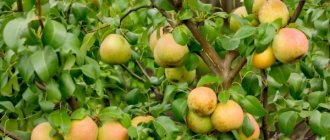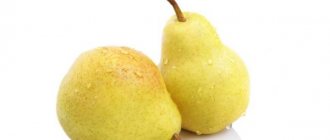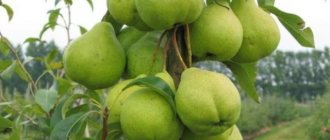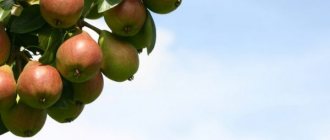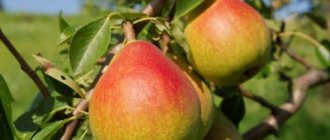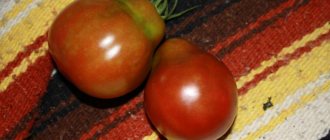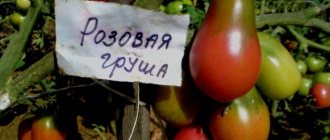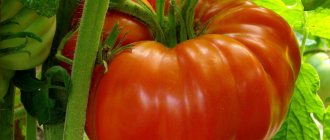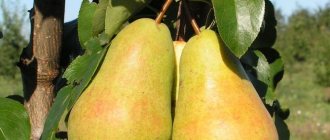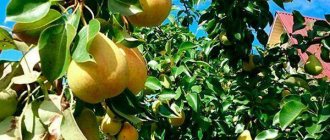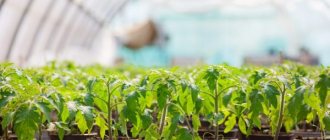Pear selection Elegant Efimova
The elegant Efimova has become known to gardeners since the 30s of the last century. The pear is named after its discoverer, who obtained it from the parent varieties Tonkovetka and Lyubimitsa Klappa. The harvest ripens in early autumn, which is very suitable for the middle zone. The plant has taken root not only in Russia, but also in neighboring countries. In terms of taste characteristics, the fruits can compete with the much-loved Prazdnichnaya variety.
What type of pear is it?
Pear "Naryadnaya Efimova" belongs to the autumn varieties with an early type of fruiting . This variety is used in hybridization as a donor of high yield and frost resistance.
At the end of the 80s, an agricultural exhibition was held in Erfurt (Germany, Thuringia).
This pear variety received special attention and was awarded
a gold medal for its excellent qualities and excellent presentation.
The appearance of the pears was rated 4.5 out of 5. Sweet and sour taste 4 points.
Sugar content varies from 9.1 to 9.3%; acid content from 0.10 to 0.13%.
Autumn pear varieties also include: Thumbelina, Svetlyanka, Pamyati Yakovleva, Tatyana, Larinskaya.
Pros and cons of fruit crops
Like any variety, Naryadnaya Efimova has its advantages and disadvantages, based on which the gardener has the opportunity to make the right choice. The advantages include:
- the ability to grow crops for commercial purposes;
- suitability of fruits for long-term storage and transportation;
- excellent taste;
- frost resistance;
- high yield rates;
- regular fruiting.
Among the disadvantages, gardeners highlight the fact that it can be quite difficult to determine exactly when it is time to harvest. Also, the pear begins to bear fruit late.
Varietal feature and characteristics of the variety
Varietal features and characteristics allow gardeners to recognize Naryadnaya Efimova among other varieties by certain characteristics, as well as learn about the peculiarities of pear agricultural technology.
Tree dimensions and height
The tree reaches a maximum height of 5 m, its crown is of medium density. The branches grow in relation to the trunk at an angle of 30°. The bark is gray, smooth.
Lifespan
The lifespan of a tree is more than 25 years, and with anti-aging pruning and proper care, this period increases.
Fruiting
The elegant pear Efimova begins to bear fruit 6-7 years after planting the seedling. The maximum weight of the fruit reaches 175 g. Initially, their color is green, but as they ripen, the fruit first turns yellow and then purple. By the time it is fully ripened, the color of the pear is almost completely burgundy.
Flowering and pollinators
The flowering of Naryadnaya Efimova does not occur simultaneously. The flowers located below bloom first, and a little later - those on top. This feature helps the pear to withstand returning spring frosts and produce a good harvest every year. The flowers are white, small in size, and have a strong, pleasant aroma.
Naryadnaya Efimova is a partially self-pollinating variety. To increase productivity, it is recommended to plant the following pears nearby:
- Bessemyanka;
- Yakovlev's favorite;
- Autumn bergamot;
- Marble;
- Muscovite.
Ripening time and harvest
Harvesting of Naryadnaya Efimova occurs in September. The exact time may vary depending on the climatic conditions of the region and prevailing weather.
Tasting qualities and use of fruits
The taste of pears of this variety is slightly astringent. In general, the tender and very juicy pulp has a balanced sweet and sour taste. The harvested crop is used for:
- fresh consumption;
- additions to creams;
- preparing cakes and confectionery;
- cooking meat dishes;
- preparations of jam and compotes;
- making marmalade;
- preparing desserts.
See also
Description and full characteristics of the Chizhovskaya pear variety, care and cultivation
Read
Frost and drought resistance
The Naryadnaya Efimova pear variety is highly frost-resistant and overwinters in the middle zone without additional shelter. The tree can tolerate moisture deficiency, but at the same time the yield drops significantly, and the taste and marketability of the fruits decrease. Also, a white powdery coating appears on young twigs and foliage.
Immunity to diseases and insects
Elegant Efimova has increased immunity to the following diseases:
- bacterial burn;
- scab;
- moniliosis;
- cancer;
- pear rust.
It is important to note that the fruits are not subject to rotting or spotting. Pears are also resistant to the negative effects of pests. Such advantages enable gardeners not only to save money and time on preventive treatments, but also allow them to harvest an environmentally friendly harvest.
Diseases and pests
The pear variety Naryadnaya Efimova has innate immunity to such common diseases as moniliosis and clasterosporiasis, however, prevention against some diseases must be carried out annually. Among the dangerous diseases are:
- I'm scabby. It affects the skin of foliage with light green spots. The disease is prevented with a 3% solution of Bordeaux mixture. During the flowering period, trees are treated with Horus in a proportion of 2 g per 10 liters of water.
- Rust. This is a disease that affects the crown. Symptoms of the disease are red spots leading to the death of foliage. The disease is vulnerable to the drug "Skor". Dilute 2 ml in 5 liters of water and treat the crown.
- Fruit rot. This is a disease caused by a fungus. It attacks fruits. Prevention includes treating the kidneys with Dnok solution. 100 g of the drug is diluted in 10 liters of liquid.
Harmful insects cause more damage to crops than diseases. The most common pests are aphids and copperheads. These insects damage fruits and foliage by feeding on their sap.
To minimize the risk of infection, every spring the trunks are cleaned of old bark and moss, diseased branches are cut off and holes are dug. One of the effective methods of controlling insects is whitewashing the trunk with lime.
Infected trees are treated with ZOV and Aktar. “ZOV” is used in early spring, before bud formation begins. "Aktar" is diluted in a proportion of 1.5 g per 10 liters of water and treated with the crown in dry times.
Planting pears Elegant Efimova
Planting the Elegant Efimova pear should be done in a well-lit place, protected from drafts. It is preferable to allocate a place for the tree on the south side of the site. There are also other features and requirements for planting work.
Optimal timing
Planting of elegant Efimova seedlings is carried out both in spring and autumn. However, in regions with cold climates, spring planting is preferable. The work is carried out during a period when a stable positive temperature has established outside, and the buds have not yet begun to bloom on the trees. In the southern regions, pears are also planted in the fall. There should be at least 2 weeks left before the onset of persistent cold weather.
Soil requirements
Elegant Efimova cannot tolerate flooded soils. If the groundwater level is too close to the soil surface, then drainage is required. It would be even better to plant the seedling on a small hill. The pear can grow even on depleted soil, but it is recommended to plant it on black soil. Both loamy and sandy soils are suitable for its cultivation.
As for acidity, only a neutral pH level is allowed for growing pears.
Planting layouts
When planting seedlings on a site, you should remember that the distance between neighboring trees is left at least 4 m. The gap between rows is about 5 m.
Preparing the site and seedlings
2 weeks before planting a pear seedling, dig a planting hole 1 m wide and 0.75 m deep. Before the plant is planted, the soil must have time to settle. The root system of a young plant is soaked in a root formation stimulator or in water with the addition of potassium humate.
To fill the planting hole, prepare a nutritious soil mixture, which includes:
- humus;
- wood ash;
- potassium sulfide;
- superphosphate.
If the soil is acidic, it is recommended to add lime. It is advisable to add additional humus and clay to sandy soil.
Technological process of planting a tree
After completing the preparatory work, a drainage layer is laid at the bottom of the hole, and then a nutrient soil mixture is poured into a mound. Carefully install the pear seedling, straighten the roots and cover it with soil so that the root collar is above its surface. After this, the soil is compacted and watered with two buckets of water, and then mulched.
How to grow a tree
The plant feels good in spacious areas that are illuminated by sunlight. If you grow it in shaded corners of the garden, the fruits will become smaller and their sweetness will decrease.
Although the elegant Efimova can grow in poor soil, it is better to place it in black soil, loamy or sandy soil. If its acidity exceeds 6 pH, the soil is fertilized with lime and wood ash.
For planting, young trees that are 1-2 years old are purchased. Their height should exceed 60 cm in the presence of formed skeletal branches. The bark on the cuttings should not have rotten areas or chips.
Pear hybrids are planted in autumn or early spring. To do this, dig a hole 0.75-0.8 m deep and up to 1 m in diameter. Manure or humus (up to 30 kg), superphosphate and potassium sulfide (0.1 kg each) are laid inside. A stake is strengthened in the center of the hole, which serves as a support for the seedling. Then they install the tree and cover it with earth. Make a circular ditch around the trunk and pour 3 buckets of warm water into it.
The description of the Naryadnaya Efimova pear states that to increase its yield, the following pollinators must be planted next to it:
- Marble,
- Bessemyanka,
- Yakovlev's favorite.
Amazing chayote (Mexican cucumber): description, cultivation and care
It is advisable to have 2-3 types of hybrids on the site. Planting care is needed throughout the growing season.
Fruit trees are irrigated every 6-7 days. To do this, early in the morning, 20 to 30 liters of oxen are poured under each young pear. If the weather is hot or drought, the intensity of moisturizing is increased 3 times. If there are fruit-bearing trees in the garden, they are watered 2 times a season (during bud break and at the end of flowering), 50-60 liters of water are poured under each plant.
Fertilizers begin to be given to pear seedlings in the spring. Fertilizing is carried out with ammonium nitrate. The next time the procedure is carried out in the fall, but the trees are already given potassium mixtures at the rate of 20 g of the substance per 10 liters of water. When forming buds, it is advisable to treat the hybrids with superphosphate, and after flowering - with nitrophoska. When ovaries appear, wood ash is introduced into the soil.
This variety needs magnesium. Feeding with microelements is carried out at the beginning of summer. To do this, use a solution of metal sulfate in water (0.2 kg of chemical per bucket of liquid).
Weeding of the tree trunk circle from weeds is carried out once a month. The soil under the pears is mulched with a layer of peat and sawdust. Its thickness must be at least 100 mm.
Pruning of pear hybrids is done in the spring. Remove all old, dried out or diseased branches, shorten young shoots by 1/3.
To prevent diseases, pears are processed as follows:
- sprayed with urea solution in early spring;
- bleach the trunks with lime 2 times a year;
- remove fallen leaves, dry and diseased branches.
Such measures are recommended only if diseased trees are found in the garden.
To prevent diseases, pears are treated
If the hybrids are attacked by garden pests, the parasites are destroyed using drugs that kill both the insects themselves and their eggs and caterpillars. Although the Naryadnaya variety suffers little from them, it is recommended to constantly inspect the plants and take protective measures in time.
An adult tree tolerates winter cold well, so it does not need special protective equipment. After planting, seedlings need to be wrapped in warm materials (2-3 years), and when the air temperature drops sharply, it is advisable to fumigate their trunks with smoke.
Rules for caring for the variety
To obtain a stable and high-quality harvest, the Naryadnaya Efimova pear requires proper care, which consists not only of timely watering and fertilizing, but also of pruning branches, shaping the crown, weeding and loosening the soil.
Irrigation and fertilization
If the weather is dry and hot outside, the pear needs to be watered additionally 3 times a week. Drying out the soil during the flowering period is unacceptable, since it is at this time that the ovaries of the future harvest are formed.
After planting a seedling, fertilizer should be applied to it only after 3 years. In the spring, it experiences a greater need for nitrogen, so the soil is fertilized with ammonium nitrate. When the pear blossoms and ovaries form, it is fed with superphosphate. In the case when the leaves of Naryadnaya Efimov begin to turn yellow in the middle of summer, it is urgently necessary to feed it with magnesium. But in the fall, potassium and phosphorus fertilizers are incorporated into the soil. Before the onset of cold weather and in the spring, humus is added under the pears.
See also
When and how to properly plant a pear tree step by step for beginners
Read
Crown formation
Due to the fact that the crown of Naryadnaya Efimov is prone to thickening, it must be pruned annually. In this case, the cut is made at the very base, leaving no stumps. In addition, they do sanitary pruning, removing all damaged and diseased branches.
Whitewash
Whitewashing the trunk is necessary not only to give the garden an aesthetic appearance, but also to prevent the spread of pests and pathogens.
For whitewashing, both lime and a special mixture are used, which is sold in gardening stores.
Loosening and weeding of the tree trunk circle
After each watering or heavy rainfall, it is necessary to loosen the soil so that it is not too dense. To avoid the appearance of weeds, regularly weed the tree trunk and mulch the ground.
Rejuvenation
Old branches are periodically removed to rejuvenate the tree. Young shoots are left in their place. This procedure is carried out once every 4 years.
Prevention of diseases and pests
Smart Efimova has a strong immunity to common diseases. Rotting and spotting of fruits is also not a problem for her. Gall mites and other pests also do not touch this pear. In this regard, the gardener does not have to think about preventive treatments and spraying; the tree does not need to be poisoned with chemicals.
Preparing for winter
Elegant Efimova tolerates cold and snowy winters well without additional shelter. The only exceptions are young seedlings that have not yet begun to bear fruit. Before the onset of cold weather, it is recommended to tie them with straw or reeds.
Care
The Naryadnaya Efimova variety does not require special conditions for growth, but proper care improves the quality of the fruit. Culture needs:
- watering;
- fertilizer;
- pruning branches.
Watering
Watering depends on the weather.
Watering mode depends on weather conditions. During spring planting, the pear is watered once every 2-3 days. In summer, during dry weather, the soil is irrigated every day. Autumn seedlings are watered abundantly during planting. One plant requires 10 liters of water.
Watering is best done by sprinkling. If it is not possible to use this method, water is poured under the root in several passes.
After irrigation and rain, the ground near the tree is loosened, otherwise the top layer of soil will harden. The root system is also mulched to slow down the process of moisture evaporation.
Fertilizer
In the first year after planting, seedlings do not need feeding. In the second year, apply organic fertilizer containing the following mineral components:
- nitrogen - 0.5%;
- potassium - 0.3%;
- phosphorus - 0.3%
1.5 kg of fertilizer is applied to one seedling. Nitrogen is added only in early spring; in summer, the pear is prepared for wintering; additional growth stimulation can harm the plant.
Foliar fertilizer plays an important role in fruit development. Before flowering, the ovaries are sprayed with a 3% superphosphate solution.
To strengthen the trunk and branches, use a 2% urea solution. Spraying is carried out 10 days before the flowers begin to form.
Oxidized soil can cause the tree to become deficient in calcium. Ash helps to avoid this. Pour 3-4 cups under one seedling. The soil is treated in a similar way in the first days of September.
Trimming
The formation of the crown is carried out in early spring. At this time, the plant has not yet restored its usual metabolic rate after wintering, so pruning the branches does not cause injury to it.
In the first year after planting, the tree does not need pruning. In the second year, the first tier of the crown is formed, leaving 2 well-developed branches, the rest are cut off into a ring. For the procedure, special garden pruners are used. If you do not prune, the pear will begin to grow unevenly. This will lead to different branches bearing fruit at different times.
The first flowering of the seedling is cut off. Without such a procedure, the tree will not have enough strength to take root in an open area.
